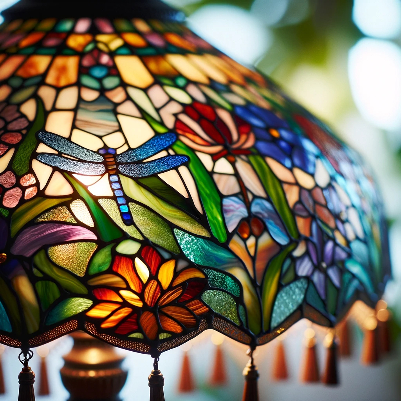Tiffany lamps, famous for their colorful stained glass windows and intricate patterns, have stood the test of time without ever losing their beauty. Among these luminous works of art, the Tiffany-style floor lamp stands out for its elegance and timeless charm. This article explores the history, features, and diverse uses of Tiffany floor lamps in contemporary décor.
History and Origins of the Tiffany Style
The Tiffany style was popularized by American artist Louis Comfort Tiffany in the early twentieth century. His stained-glass creations were initially intended for churches before becoming masterpieces in bourgeois homes of the time.
Evolution of Design
- Tiffany style lamp: Initially designed as a table lamp, it has evolved into various shapes including the floor lamp.
- Art Deco lamp: Influenced by the Art Deco movement, some Tiffany lamps adopt more geometric and symmetrical patterns, marking a stylistic transition.
The Tiffany style, originally developed by Louis Comfort Tiffany in the early twentieth century, was first recognized for its innovative use of colored glass and its artistic approach to everyday objects. Louis Tiffany, the son of a famous jeweller, was deeply influenced by Art Nouveau and its nature-inspired motifs. This influence is clearly visible in early Tiffany lamp designs, which often featured intricate floral and organic designs.
Transition to Art Deco
Over the decades, with the advent of Art Deco in the 1920s and 1930s, the design of Tiffany lamps began to incorporate more geometric and symmetrical elements.
This period saw the emergence of the Art Deco lamp which, while retaining the use of stained glass, is distinguished by its more structured and less fluid forms than the Art Nouveau style. The patterns became more simplified and uncluttered, reflecting the time's craze for industrialization and modernity.
Diversity of Forms

At the same time, the product range has diversified to include not only table lamps but also floor lamps, pendant lamps and wall lamps.
The Tiffany-style floor lamp, in particular, has become popular as an accent piece in home interiors, offering not only a source of light but also a major decorative element.
Influence on Modern Creations
Today, Tiffany-inspired designs continue to evolve, with modern designers taking traditional techniques to create pieces tailored to contemporary tastes. Although manufacturing techniques and materials have evolved, the essence of Tiffany design—the artistic use of glass and vibrant colors—remains highly prized.
Street lamps and more Tiffany style lamps Modern styles can vary greatly in terms of colour, pattern and shape, providing a wide range of choices for interior design enthusiasts.
These evolutions show how the Tiffany-style floor lamp has stood the test of time, adapting to trends while maintaining its unique identity and aesthetic appeal.
These pieces remain privileged witnesses of the artistic periods they have gone through, making each lamp not only a source of light but also a piece of history.
Features of Tiffany Floor Lamps
Tiffany-style floor lamps are recognizable by their stained glass shade, assembled by hand with hundreds of pieces of colored glass.
Materials & Manufacturing
- Stained glass: Each piece of glass is cut, ground, and soldered with tin, forming floral, geometric, or abstract patterns.
- Base: The base of floor lamps is often made of metal, worked to complement the design of the lampshade.
Integration into Modern Decoration
Using a stained glass floor lamp in a modern interior can be done in a number of ways, depending on the mood you want to create.
Choosing the perfect location
- In the living room: Place the floor lamp in a reading nook or next to the sofa for soft, colorful light.
- In-room: A Tiffany floor lamp can serve as an accent light, creating a relaxing and intimate atmosphere.
Purchase & Care Advice
Purchase
Buying a Tiffany-style floor lamp requires attention and discernment, especially if you opt for a vintage piece. Check the authenticity and condition of the stained glass.
Maintenance
- Stained glass cleaning: Use a soft, slightly damp cloth to clean the glass pieces without scratching them.
- Base care: Buff the metal regularly to maintain its shine.
Why Choose a Tiffany Floor Lamp?
Opting for a Tiffany-style floor lamp is a bold décor choice that brings not only light but also art to your living space.
These street lamps aren't just sources of light; They are collector's items that tell a story of creativity and style.
Conclusion
The Tiffany-style floor lamp is more than just a decorative object; It is an invitation to appreciate the marriage between art and utility.
Whether you're a vintage aficionado or just looking to inject some color and personality into your space, a Tiffany floor lamp is a great choice. With its distinctive look and vibrant colors, it's sure to become the focal point of any room.


